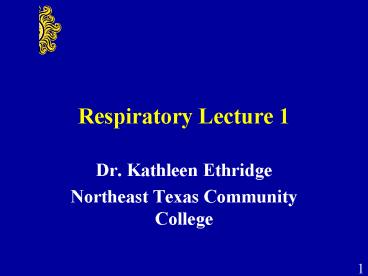Respiratory Lecture 1 - PowerPoint PPT Presentation
1 / 36
Title:
Respiratory Lecture 1
Description:
Chest Wall Assessment. Thoracic Excursion ... Flat sounds. Tympanic sounds. 13. Sequence of Auscultation. Assess. character of breath sounds ... – PowerPoint PPT presentation
Number of Views:60
Avg rating:3.0/5.0
Title: Respiratory Lecture 1
1
Respiratory Lecture 1
- Dr. Kathleen Ethridge
- Northeast Texas Community College
2
Upper Airway
- Nasal passages
- Nasopharynx
- Oropharynx
3
Lower Airway
- Larynx
- Trachea
- Lungs
- Bronchi
- Alveoli
- Pleura
4
Function of the Respiratory System
- Ventilation
- the movement of air in and out of the lungs
- Compliance
- Surface Tension
- Muscular Effort
- Resistance
5
Ventilation Perfusion
- Shunting
- When perfusion exceeds ventilation
- Dead Space
- When ventilation exceeds perfusion
6
Oxyhemoglobin Dissociation
- Oxygen affinity is related to
- pH
- PCO2
- Body Temperature
- 2,3,DPG
7
Geriatric Considerations
- Changes in respiratory structure
- decreased elasticity
- decreased vital capacity
8
Assessment of the Respiratory System
9
Chest Deformities
- Barrel chest
- Pigeon chest
- Funnel chest
- Kyphoscoliosis
10
Assess Fingers and Toes
- Clubbing
- occurs when a chronic hypoxia is present
- normal nail bed angle 160 degrees
11
Chest Wall Assessment
- Thoracic Excursion
- As the client inhales, the hands move up and out
symmetrically - Abnormal - hands move asymmetrical
- Tactile Fremitus
- Palpation as the client says words that produce
vibrations
12
Chest Percussion
- Various sounds are described as
- Resonant sounds
- Hyperresonant sounds
- Dull sounds
- Flat sounds
- Tympanic sounds
13
Sequence of Auscultation
- Assess
- character of breath sounds
- presence of abnormal sounds
- identify the sequence for auscultation over all
areas of the lungs - from right to left
- posterior
- lateral
- anterior
14
Location of Normal Breath Sounds
- Anterior
- Posterior
- (see picture)
15
Auscultation of Lungs
- Bronchial (tracheal)
- high pitch
- Bronchovesicular
- moderate pitch
- Vesicular
- low, soft
16
Abnormal Breath Sounds
- Crackles
- fine
- coarse
- Pleural friction rub
- Wheeze (rhonchi)
- high-pitch
- low-pitch
17
Voice Sounds
- Bronchophony
- Egophony
- Whispered pectoriloquy
18
Diagnostic Tests
- Pulmonary function tests (PFT)
- Pulse Oximetry
- Capnography
- measures exhaled carbon dioxide for a client on a
ventilator - Arterial Blood Gas
- Scans
- MRI
19
Bronchoscopy
- Provides for direct visualization
- Client is NPO for 6 hours prior
- Preop med is given airway is anesthetized
topically - After the exam, evaluate for return of gag reflex
- Observe for complications (possible pneumothorax)
20
Pulmonary Angiography
- Contrast material is injected into the pulmonary
arteries - Conducted in X-ray department
- Watch for complications
- cardiac dysrhythmias
- reaction to dye
21
Thoracentesis
- Withdrawal of fluid from the pleural cavity
- Used for diagnostic and therapeutic reasons
- Nurse responsible for
- explain procedure
- position client
- give support
- monitor vital signs
22
Management of Airway Disorders
23
Tracheostomy
- A surgical opening into the trachea
- Used to maintain airway over an extended period
of time - Must establish method of communication
- Maintain safety
- Assess breathing
- Maintain cuff pressure appropriately
24
Cancer of the Larynx
- A malignancy of the larynx
- Glottic Tumor
- Supraglottic Tumor
- Subglottic Tumor
25
Clinical Symptoms of Laryngeal Cancer
- Warning Signs
- voice changes
- a lump
- a cough or sore throat that does not get well
- coughing up bloody sputum
- earache
- swelling that causes difficult swallowing and/or
breathing
26
Diagnosing Laryngeal Cancer
- Direct or indirect laryngoscopy
- Biopsy for tumor staging
- T measure tumor
- N lymph nodes involved
- M mestatasis
- MRI
- CT scan
27
Treatment for Laryngeal Cancer
- Ablation
- Radiation
- Chemotherapy
- Laser surgery
28
Partial Laryngectomy
- Only part of the larynx is removed
- Swallowing difficulties
- Vocal cords preserved
29
Complications of Surgery
- Page 1666
- 1. Airway Obstruction
- 2. Hemorrhage
- 3. Carotid Artery Rupture
- (watch for pulsating trach tube)
- 4. Fistula Formation
30
Total Laryngectomy
- Clients most often have a permanent tracheostomy
- Complete loss of normal speech and smell
31
Total Laryngectomy
- Nursing management
- preop
- emotional needs
- artificial speech/method of communication
- postop
- respiratory status
- pain
- complications
32
Client Teaching Guide
- Covering and Cleaning stoma
- No swimming/ no smoking
- Loss of smell - use smoke detectors
- ID bracelet
33
Radical Neck Dissection
- May have radical change in appearance
- May have lack of sensation
- Range of motion exercises are essential
34
Laryngospasm
- Laryngospasm
- spasm of the laryngeal muscles
- may occur
- after anesthesia
- after intubation
- after extubation
- treatment
- oxygen
- brochodilators
35
Other Disorders of Larynx
- Laryngeal paralysis
- Trauma or Injury
36
The End































